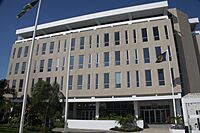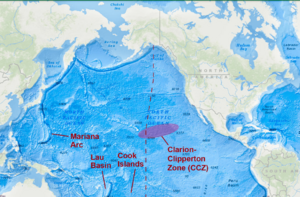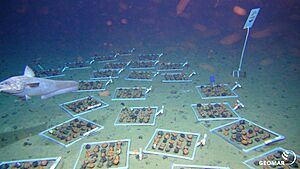International Seabed Authority facts for kids

ISA Headquarters
|
|
| Abbreviation | ISA |
|---|---|
| Formation | 16 November 1994 |
| Type | Intergovernmental organization |
| Purpose | Regulate deep seabed mining and ensure the marine environment is protected from any harmful effects which may arise from mining activities |
| Headquarters | Kingston, Jamaica |
|
Membership (2018)
|
168 states parties |
|
Secretary-General
|
Leticia Carvalho |
|
Main organ
|
Assembly of the International Seabed Authority |
| Affiliations | Observer to the United Nations General Assembly |
|
Budget (2017 & 2018)
|
$17.1 Million |
The International Seabed Authority (ISA) is a special group of 167 countries and the European Union. It is based in Kingston, Jamaica. The ISA was created in 1994 under a big agreement called the United Nations Convention on the Law of the Sea (UNCLOS).
The ISA has two main jobs. First, it manages and controls mining activities for minerals found deep under the ocean. This area is called "The Area" and is considered the "common heritage of all mankind". This means it belongs to everyone. Second, the ISA works to protect the ocean floor and its environment from any harm that mining might cause. This includes the deep sea, which is water deeper than 200 meters (656 feet).
Since it started, the ISA has approved many contracts for exploring the ocean floor for minerals. Most of this exploration happens in the Clarion–Clipperton zone between Hawaii and Mexico. This area has special rocks called polymetallic nodules that contain important metals like copper and cobalt. These metals are used in things like electric batteries.
So far, the ISA has not allowed any actual mining to start. They are still working on the rules for mining. Many scientists and environmental groups are asking for a pause on deep-sea mining. They worry that it could really hurt the ocean, which is important for our planet and home to many unique creatures. The ISA gets its money from its member countries and from companies that want to explore for minerals.
Contents
How the ISA Started
The International Seabed Authority held its very first meeting in Jamaica on November 16, 1994. This was the same day that the main ocean law, the United Nations Convention on the Law of the Sea, officially began.
In October 1996, the ISA became an observer at the United Nations General Assembly. This means they can attend UN meetings and share their ideas. The ISA works by making agreements with companies and other groups. These agreements allow them to explore for minerals like cobalt, nickel, and manganese on the deep seabed.
The Ocean Floor: Everyone's Heritage
A very important idea behind the ISA is that the deep ocean floor and its resources are the "common heritage of all mankind." This means these areas do not belong to any one country. Instead, they belong to everyone on Earth.
Because of this, the ISA must make sure that any activities in "The Area" are done peacefully. They also make sure that any money made from these resources is shared fairly. Developing countries, which are often poorer nations, get special help.
How the ISA is Run
The ISA has a Secretary-General and two main groups that help run it and make decisions. These are the Assembly and the Council.
The Secretary-General
The Secretary-General is like the main boss of the ISA. They are in charge of the staff and write a yearly report for the Assembly. The Assembly chooses the Secretary-General for a four-year term. The person in this job is not allowed to own any part of the mining companies that the ISA works with.
Here are the people who have been Secretary-General since the ISA started:
| Country | Image | Name | Term |
|---|---|---|---|
 |
Satya Nandan | 1996–2008 | |
 |
Nii Allotey Odunton | 2008−2016 | |
 |
Michael Lodge | 2016–2024 | |
 |
Leticia Carvalho | 2025– |
The Assembly
The Assembly includes all the countries that are members of the ISA. This group chooses the 36 members of the Council. They also elect the Secretary-General from a list of candidates suggested by the Council. The Assembly also has the power to approve or reject new rules for seabed mining. They decide how any money from mining should be shared and approve the ISA's yearly budget.
The Council
The Council has 36 members chosen by the Assembly. This group gives permission to governments and private companies to explore and mine the international seabed. They also create the rules and procedures for how the ISA works, but these rules must be approved by the Assembly. The Council also suggests who should be the next Secretary-General. The ISA usually holds its main meetings in Kingston for two weeks each year.
Advisory Groups
There are also two smaller groups that give advice. The Legal and Technical Commission has 30 members and advises the Council. The Finance Committee has 15 members and deals with money matters. All members of these groups are experts chosen by governments.
The Enterprise
The original agreement also set up a group called the Enterprise. This group was meant to be the ISA's own mining company. The idea was that it could make a lot of money to share with developing countries. However, some environmental groups like Greenpeace have worried that if the ISA is both a rule-maker and a mining company, it could be a problem. The ISA says there is no conflict.
ISA's Area of Control
The UNCLOS agreement explains what part of the ocean floor the ISA is in charge of. It's called "The Area" and it's the seabed and ocean floor that are beyond any country's national control. Countries usually control waters up to 200 nautical miles from their coast. If a country can show its land naturally extends further, it might claim up to 350 nautical miles. The ISA does not decide these boundaries. Another group, the Commission on the Limits of the Continental Shelf, handles that.

Exploring and Mining the Deep Sea
Commercial Mining Plans
Even though the ISA has not approved any commercial mining yet, they expect it could start soon. They are working on the final rules for mining. In 2021, the island nation of Nauru set a deadline. This means the ISA must approve the final mining rules by July 2023. If not, companies might be allowed to mine using the rules that are already drafted.
Exploration Activities
Exploration for minerals involves using special tools. This includes mapping the deep sea, using manned submarines or robots, taking photos and videos, and drilling into the seabed.
The Clarion–Clipperton Zone
Most of the exploration happens in the Clarion–Clipperton zone (CCZ). This huge area is in the Pacific Ocean, between Hawaii and Mexico. The CCZ is known for its polymetallic nodules. These are potato-sized lumps that formed over millions of years. They contain valuable metals like nickel, manganese, copper, zinc, and cobalt.
The CCZ is also home to amazing deep-sea creatures. These include deep-water corals, sponges, and unusual animals like "ghost octopus," crabs, worms, and sea cucumbers. In the dark deep sea, these creatures often attach themselves to the rock-like nodules for shelter. Companies want to mine these nodules because the metals are needed for electric car batteries, smartphones, and renewable energy.
Other Exploration Areas
Exploration contracts for polymetallic nodules have also been given out for areas in the Central Indian Ocean Basin and the Western Pacific Ocean. The ISA has also given contracts to explore for other types of minerals. These include polymetallic sulphides in places like the Southwest Indian Ridge and the Mid-Atlantic Ridge. They also have contracts for cobalt-rich crusts in the Western Pacific Ocean.
What Contractors Must Do
Companies that get exploration contracts must follow certain rules. They need to have a plan for what to do if something goes wrong during exploration. They must also report on their activities every year. Plus, they need to offer training programs for people from developing countries.
List of Exploration Companies
The ISA has signed 15-year contracts with 22 different groups for exploration. These groups are looking for polymetallic nodules, polymetallic sulphides, and cobalt-rich crusts.
Some of the early contracts were signed in 2001-2002 with groups from Russia, Korea, China, Japan, France, and India. In 2006, Germany also signed a contract.
Later, in 2008, private companies from the Pacific island nations of Nauru and Tonga also applied. Nauru Ocean Resources Inc. got a contract in 2011, and Tonga Offshore Mining Limited in 2012.
More contracts for polymetallic nodules were given to groups from Belgium (2013), Kiribati (2015), Singapore (2015), the UK (2013 and 2016), Cook Islands (2016), and China (2017).
For polymetallic sulphides, contracts were signed with groups from China (2011), Russia (2012), Korea (2014), France (2014), Germany (2015), India (2016), and Poland (2018).
For cobalt-rich crusts, contracts were signed with groups from China (2014), Japan (2014), Russia (2015), Brazil (2015), and Korea (2018).
ISA Activities
Making Rules
One of the ISA's biggest achievements was creating rules in 2000 for exploring polymetallic nodules. These nodules are like potato-sized lumps on the ocean floor. They contain important metals like manganese, cobalt, copper, and nickel. They are mostly found in the central Pacific Ocean in the Clarion–Clipperton zone, but also in the Indian Ocean.
In 2013, the ISA updated its rules for deep-sea exploration. These new rules said that companies should be careful to avoid polluting the ocean. They also must tell the Secretary-General right away if any exploration activities cause problems for the marine environment. The rules also allowed companies to collect a small amount of material for testing, but not to sell it.
In July 2019, the ISA's Legal and Technical Commission prepared new "Draft regulations on exploitation of mineral resources in the Area." These rules are for when actual mining might begin.
The ISA also made rules for exploring polymetallic sulphides in 2010. In 2012, they added rules for exploring cobalt-rich ferromanganese crusts.
Workshops and Research
Besides making rules, the ISA also holds yearly workshops. These meetings discuss different parts of seabed exploration. A big focus is on how to protect the ocean environment from any harm. The ISA shares what they learn from these meetings through publications.
For example, studies on the Central Pacific mineral area led to a report on ocean life and how to manage the effects of deep seabed mining. A workshop in Hawaii in 2007 suggested setting up "preservation reference areas" in the Clarion–Clipperton zone. In these areas, mining would not be allowed to keep the natural environment safe.
Recently, the ISA has held workshops on helping women get involved in deep-sea science. They also discussed how to manage deep seabed resources in a way that lasts. Other sessions focused on resources and technologies for deep-sea mining in Africa, and how to share the money made from deep-sea mining.
National Trends in Seabed Mining
In recent years, there has been more interest in deep sea mining. This is especially true for ferromanganese crusts and polymetallic sulphides. Several companies are now working in waters controlled by countries like Papua New Guinea, Fiji, and Tonga. Papua New Guinea was the first country to give permission for commercial exploration of seafloor sulphide deposits in 1997.
Japan's new ocean policy also focuses on developing resources like methane hydrate and hydrothermal deposits within its own waters. They hope to start commercial mining of these resources within the next 10 years.
There is also a lot of interest in mining the seabed in the Arctic Ocean. This area is bordered by Canada, Denmark, Iceland, Norway, Russia, and the United States. In 2020, environmental groups asked Norway not to allow deep-sea mining in its waters. They also asked Norway to speak out against Arctic mining at the International Seabed Authority.
Endowment Fund
In 2006, the ISA created a special fund called the Endowment Fund. This fund helps support scientific research in the international seabed area. It helps experienced scientists and technicians from developing countries take part in deep-sea research. In 2008, a campaign started to find participants and get more money for the fund. The ISA started the fund with $3 million.
Voluntary Commitments
In 2017, the ISA made seven voluntary promises to the UN Oceans Conference. These promises support a global goal to protect the oceans. They included:
- Helping more women get involved in marine scientific research.
- Encouraging the sharing of research results through an award for deep-sea research.
- Working with the UN to support "Blue Growth" in the deep sea.
- Helping African countries develop their deep seabed resources sustainably.
- Improving how we assess the important natural functions of the deep sea using underwater observatories.
- Improving how we assess deep-sea biodiversity by creating online guides to species.
See also
- UNCLOS (United Nations Convention on the Law of the Sea)
- Commission on the Limits of the Continental Shelf
- Deep Sea Mining
- Clarion–Clipperton zone
- Polymetallic nodules
- International waters



